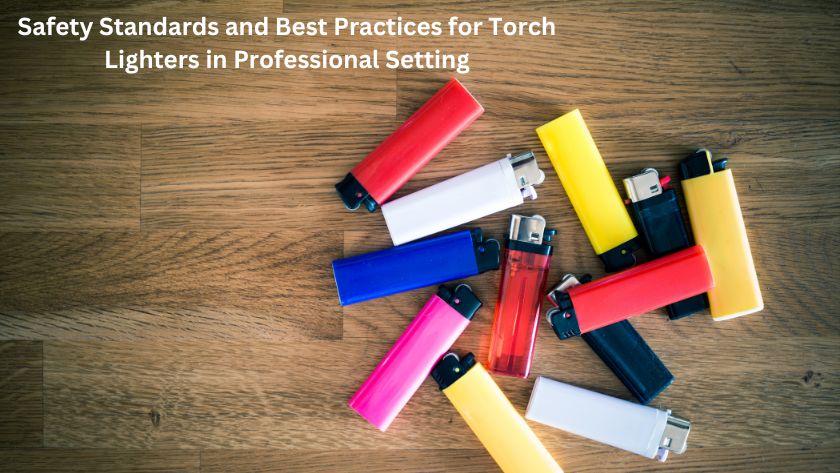Safety Standards and Best Practices for Torch Lighters in Professional Setting

In professional environments where precision and reliability are paramount, the choice of tools can significantly impact outcomes. Among these tools, torch lighters stand out for their specialized applications, ranging from culinary arts to industrial tasks. Unlike their traditional counterparts, torch lighters offer a higher degree of control and efficiency, making them indispensable in scenarios where a steady and intense heat source is required. Their popularity in professional settings emphasized not only their utility but also the need for users to understand and adhere to safety standards.
Torch Lighters vs. Traditional Lighters
Advantages
Torch lighters have carved out a niche for themselves in the professional world, thanks to their unique advantages over traditional lighters. Unlike the latter, which often struggle in windy conditions and offer limited control over the flame size, torch lighters boast a powerful jet flame lighter mechanism. This technology allows for a concentrated and intense flame that remains stable in various environmental conditions, making it an invaluable tool for tasks requiring efficiency.
Windproof Capabilities
One of the standout features of torch lighters is their windproof capabilities, thanks to the advanced jet flame technology they employ. This technology ensures that the flame produced is not only highly concentrated but also resistant to being blown out by the wind. This makes torch lighters an ideal choice for outdoor use, where conditions can be unpredictable. Whether it’s for lighting a grill, starting a campfire, or conducting outdoor repairs, the windproof torch lighters ensure that they perform reliably.
Applications
From culinary settings where chefs use them to achieve a perfect finish on dishes, to jewelry makers who rely on the precise flame for detailed work, the applications are vast. Additionally, in industries where working outdoors is common, such as construction and landscaping, durable torchlighters prove invaluable. This wide applicability demonstrates the significant role that torchlighters play across various professions.
The Right Way to Refill Torch Lighters
Choosing the Correct Fuel
Selecting the appropriate fuel is the first step in ensuring the optimal performance of your torch lighter. Butane is the most commonly recommended fuel for torch lighters, as it burns cleanly and efficiently. However, not all butane is created equal. It’s important to choose high-quality, triple-refined butane to minimize impurities that can clog the lighter’s mechanism.
Step-by-Step Guide to Refilling Safely
By following a few key steps, you can refill your torch lighter with confidence, minimizing the risk of accidents and ensuring a steady, reliable flame for your needs. Here’s a detailed guide on how to do it properly:
- Ensure the Lighter is Empty: Before refilling, make sure your lighter is empty. You can do this by pressing down on the refill valve to release any remaining gas. This step is crucial to prevent overfilling and potential leakage.
- Prepare the Lighter and Fuel: Shake the butane canister well and attach the filling nozzle firmly. This helps to ensure that the fuel flows smoothly into the lighter.
- Refill in the Correct Position: Invert the lighter and press the nozzle of the butane into the lighter’s filling valve. Keep them in a straight line to avoid leakage.
- Fill Slowly: Press the canister gently to start refilling. You’ll want to fill the lighter in short bursts, allowing the gas to settle before adding more. This method prevents overfilling and ensures a safer refilling process.
- Check for Leaks: Once filled, wait a few minutes for any excess gas to evaporate, then check for leaks by listening or feeling for any escaping gas. If you detect a leak, it may indicate that the refill was not done correctly or that there’s an issue with the lighter’s valve.
Refilling your torch lighter correctly is an essential practice for anyone who relies on these tools. Whether you’re using your lighter for culinary purposes, lighting cigars, or any other application, following these steps ensures that your lighter is safely filled and ready.
Understanding Manufacturer’s Guidelines
Familiarizing yourself with the manufacturer’s guidelines is not only about following instructions; it’s about understanding the design and mechanics of your refillable lighter to use it safely and efficiently. Ignoring it can lead to decreased lighter performance, potential safety hazards, or even damage to the lighter.
Maintenance Tips for Torch Lighters
Regular Care
Torch lighter maintenance is essential to extend its durability and ensure optimal functionality. Simple practices like wiping the exterior with a soft cloth to remove debris and checking the fuel level regularly can significantly impact its performance. Ensuring the flame adjustment is set correctly can also prolong the lifespan of your lighter, preventing unnecessary stress on its components.
Cleaning and Storage Best Practices
Proper cleaning and storage are pivotal in maintaining efficiency and extending the life of the best torch lighter. Over time, lighters can accumulate dust and debris that may hinder their performance. Here’s how to keep your torch lighter in pristine condition:
- Ensure the lighter is cool and not recently used. This prevents any accidental burns or fuel evaporation.
- Disengage the fuel tank. For lighters that allow it, removing the fuel tank can make cleaning more thorough.
- Use compressed air. Gently blow compressed air around the ignition and flame areas to dislodge any accumulated debris.
- Lubricate moving parts. If the manufacturer recommends it, apply a small amount of lubricant to the lighter’s hinge or wheel.
- Store in a cool, dry place. Humidity and temperature extremes can affect the lighter’s fuel and mechanical parts, so it’s best to store it in a controlled environment.
Incorporating these practices into your routine ensures that your torch lighter remains clean, functional, and ready for use whenever you need it. Such attention to care and storage maximizes the lighter’s lifespan, ensuring it remains a reliable tool in your professional arsenal.
Troubleshooting Common Issues
When facing issues with your torch lighter, such as a weak flame or difficulty igniting, a few troubleshooting steps can often resolve these problems. If the fuel is sufficient, adjust the flame height using the control mechanism. Sometimes, air trapped in the fuel tank can also cause issues, so bleeding the lighter to remove any air pockets may be necessary. If the lighter still fails to operate correctly after these steps, seeking professional maintenance may be the best course of action.
Selecting the Best Torch Lighters for Professional Use
Criteria for Choosing
Firstly, the reliability of the lighter is paramount; it should ignite consistently and maintain a steady flame under various conditions. Another vital aspect is the adjustability of the flame; a lighter that offers precise control over flame size and intensity allows for more versatile use across different tasks. Additionally, ease of use and ergonomic design are important for preventing fatigue during extended use, especially in professions requiring frequent use of the lighter. Lastly, considering the material and construction quality of the lighter can provide insight into its longevity.
Comparing Models and Brands for Best Fit
Each brand offers unique features, from advanced safety mechanisms to innovative fuel efficiency technologies. Reading reviews, consulting with industry peers, and, if possible, testing lighters firsthand can provide valuable insights into their performance and suitability for your specific needs. Taking the time to research and compare can lead to a more informed decision.
Safety Protocols for Using Torch Lighters
Training and Awareness
Employees should undergo regular training sessions on the proper use and handling of torch lighters, including how to refill torch lighters safely and how to perform basic maintenance checks. Awareness campaigns can also highlight the risks associated with improper use, reinforcing the importance of following best practices. Through education, workers become more conscious of potential hazards and more adept at avoiding them.
Emergency Measures
Despite all precautions, accidents can happen. It’s crucial to have emergency measures in place and to ensure that all staff are familiar with these protocols. This includes having fire extinguishers readily available, knowing how to use them, and understanding the basics of first aid in case of burns or other injuries related to reusable lighter use. Quick and efficient responses to accidents can significantly reduce the severity of injuries and prevent situations from escalating.
The journey through the world of torch lighters has illuminated their significance in professional settings, highlighting their advantages over traditional lighters, the nuances of proper maintenance, the criteria for selection, and the paramount importance of safety. The future of torch lighters in professional settings looks bright, marked by innovation, environmental stewardship, and an unwavering commitment to excellence.




